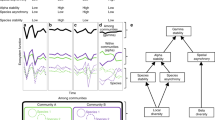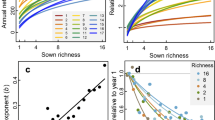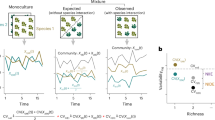Abstract
Studies of experimental grassland communities1,2,3,4,5,6,7 have demonstrated that plant diversity can stabilize productivity through species asynchrony, in which decreases in the biomass of some species are compensated for by increases in others1,2. However, it remains unknown whether these findings are relevant to natural ecosystems, especially those for which species diversity is threatened by anthropogenic global change8,9,10,11. Here we analyse diversity–stability relationships from 41 grasslands on five continents and examine how these relationships are affected by chronic fertilization, one of the strongest drivers of species loss globally8. Unmanipulated communities with more species had greater species asynchrony, resulting in more stable biomass production, generalizing a result from biodiversity experiments to real-world grasslands. However, fertilization weakened the positive effect of diversity on stability. Contrary to expectations, this was not due to species loss after eutrophication but rather to an increase in the temporal variation of productivity in combination with a decrease in species asynchrony in diverse communities. Our results demonstrate separate and synergistic effects of diversity and eutrophication on stability, emphasizing the need to understand how drivers of global change interactively affect the reliable provisioning of ecosystem services in real-world systems.
This is a preview of subscription content, access via your institution
Access options
Subscribe to this journal
Receive 51 print issues and online access
$199.00 per year
only $3.90 per issue
Buy this article
- Purchase on SpringerLink
- Instant access to full article PDF
Prices may be subject to local taxes which are calculated during checkout



Similar content being viewed by others

References
Hector, A. et al. General stabilizing effects of plant diversity on grassland productivity through population asynchrony and overyielding. Ecology 91, 2213–2220 (2010)
Isbell, F. I., Polley, H. W. & Wilsey, B. J. Biodiversity, productivity and the temporal stability of productivity: patterns and processes. Ecol. Lett. 12, 443–451 (2009)
Tilman, D., Reich, P. B. & Knops, J. M. H. Biodiversity and ecosystem stability in a decade-long grassland experiment. Nature 441, 629–632 (2006)
Reich, P. B. Elevated CO2 reduces losses of plant diversity caused by nitrogen deposition. Science 326, 1399–1402 (2009)
Naeem, S., Thompson, L. J., Lawler, S. P., Lawton, J. H. & Woodfin, R. M. Declining biodiversity can alter the performance of ecosystems. Nature 368, 734–737 (1994)
Bezemer, T. M. & van der Putten, W. H. Ecology: diversity and stability in plant communities. Nature 446, E6–E7 (2007)
Cardinale, B. J. Biodiversity loss and its impact on humanity. Nature 486, 59–67 (2012)
Vitousek, P. M., Mooney, H. A., Lubchenco, J. & Melillo, J. M. Human domination of Earth’s ecosystems. Science 277, 494–499 (1997)
Selmants, P. C., Zavaleta, E. S., Pasari, J. R. & Hernandez, D. L. Realistic plant species losses reduce invasion resistance in a California serpentine grassland. J. Ecol. 100, 723–731 (2012)
Zavaleta, E. S. & Hulvey, K. B. Realistic species losses disproportionately reduce grassland resistance to biological invaders. Science 306, 1175–1177 (2004)
Srivastava, D. S. & Vellend, M. Biodiversity–ecosystem function research: is it relevant to conservation? Annu. Rev. Ecol. Evol. Syst. 36, 267–294 (2005)
Loreau, M. et al. Biodiversity and ecosystem functioning: current knowledge and future challenges. Science 294, 804–808 (2001)
Ives, A. R. & Carpenter, S. R. Stability and diversity of ecosystems. Science 317, 58–62 (2007)
Tilman, D. & Downing, J. A. Biodiversity and stability in grasslands. Nature 367, 165–175 (1994)
McNaughton, S. J. Stability and diversity of ecological communities. Nature 274, 251–253 (1978)
Huston, M. A. Hidden treatments in ecological experiments: re-evaluating the ecosystem function of biodiversity. Oecologia 110, 449–460 (1997)
Yachi, S. & Loreau, M. Biodiversity and ecosystem productivity in a fluctuating environment: the insurance hypothesis. Proc. Natl Acad. Sci. USA 96, 1463–1468 (1999)
Loreau, M. & de Mazancourt, C. Species synchrony and its drivers: neutral and nonneutral community dynamics in fluctuating environments. Am. Nat. 172, E48–E66 (2008)
Loreau, M. From Populations to Ecosystems: Theoretical Foundations for a New Ecological Synthesis (Princeton Univ. Press, 2010)
Sankaran, M. & McNaughton, S. J. Determinants of biodiversity regulate compositional stability of communities. Nature 401, 691–693 (1999)
Bai, Y., Han, X., Wu, J., Chen, Z. & Li, L. Ecosystem stability and compenatory effects in the inner Mongolia grassland. Nature 431, 181–184 (2004)
Yang, Z. L., van Ruijven, J. & Du, G. Z. The effects of long-term fertilization on the temporal stability of alpine meadow communities. Plant Soil 345, 315–324 (2011)
Yang, H. J. et al. Diversity-dependent stability under mowing and nutrient addition: evidence from a 7-year grassland experiment. Ecol. Lett. 15, 619–626 (2012)
Stevens, C. J., Dise, N. B., Mountford, J. O. & Gowing, D. J. Impact of nitrogen deposition on the species richness of grasslands. Science 303, 1876–1879 (2004)
Hautier, Y., Niklaus, P. A. & Hector, A. Competition for light causes plant biodiversity loss after eutrophication. Science 324, 636–638 (2009)
Tilman, D. Biodiversity: population versus ecosystem stability. Ecology 77, 350–353 (1996)
Adler, P. B. et al. Productivity is a poor predictor of plant species richness. Science 333, 1750–1753 (2011)
Borer, E. T. et al. Finding generality in ecology: a model for globally distributed experiments. Methods Ecol. Evol. 5, 65–73 (2014)
May, R. M. Stability and Complexity in Model Ecosystems (Princeton Univ. Press, 1973)
Pimm, S. L. The complexity and stability of ecosystems. Nature 307, 669–674 (1984)
Hijmans, R. J., Cameron, S. E., Parra, J. L., Jones, P. G. & Jarvis, A. Very high resolution interpolated climate surfaces for global land areas. Int. J. Climatol. 25, 1965–1978 (2005)
Harpole, W. S. & Tilman, D. Grassland species loss resulting from reduced niche dimension. Nature 446, 791–793 (2007)
McNaughton, S. J. Diversity and stability of ecological communities: a comment on the role of empiricism in ecology. Am. Nat. 111, 515–525 (1977)
Fargione, J. et al. From selection to complementarity: shifts in the causes of biodiversity–productivity relationships in a long-term biodiversity experiment. Proc. R. Soc. Lond. B 274, 871–876 (2007)
Lauenroth, W. K., Hunt, H. W., Swift, D. M. & Singh, J. S. Estimating aboveground net primary production in grasslands: a simulation approach. Ecol. Modell. 33, 297–314 (1986)
Oesterheld, M. & McNaughton, S. J. in Methods in Ecosystem Science (eds Sala, O. E., Jackson, R. B., Mooney, H. A. & Howarth, R. W. ) 151–157 (Springer, 2000)
Hector, A. et al. Plant diversity and productivity experiments in European grasslands. Science 286, 1123–1127 (1999)
Spehn, E. M. et al. Ecosystem effects of biodiversity manipulations in European grasslands. Ecol. Monogr. 75, 37–63 (2005)
de Mazancourt, C. et al. Predicting ecosystem stability from community composition and biodiversity. Ecol. Lett. 16, 617–625 (2013)
Loreau, M. & de Mazancourt, C. Biodiversity and ecosystem stability: a synthesis of underlying mechanisms. Ecol. Lett. 16, 106–115 (2013)
Pinheiro, J. C. & Bates, D. M. Mixed-Effects Models in S and S-Plus (Springer, 2000)
R Development Core Team. A Language and Environment for Statistical Computing (R Foundation for Statistical Computing, 2012)
Acknowledgements
The research leading to these results has received funding from the European Union Seventh Framework Programme (FP7/2007-2013) under grant agreement no. 298935 to Y.H. (with A.H. and E.W.S.). This work was generated using data from the Nutrient Network (http://www.nutnet.org) experiment, funded at the site-scale by individual researchers. Coordination and data management have been supported by funding to E.T.B. and E.W.S. from the National Science Foundation Research Coordination Network (NSF-DEB-1042132), the Long Term Ecological Research (LTER) programme (NSF-DEB-1234162 to Cedar Creek as well as other LTER sites), and the Institute on the Environment at the University of Minnesota (DG-0001-13). We also thank the Minnesota Supercomputer Institute for hosting project data, and the Institute on the Environment for hosting Network meetings. We thank R. S. L. Veiga, F. Isbell, R. K. Didham, H. McGinness and M. O’Brien for suggestions that improved the manuscript.
Author information
Authors and Affiliations
Contributions
E.W.S., E.T.B., W.S.H. and E.M.L. are Nutrient Network coordinators. Y.H. and A.H. developed and framed research questions. Y.H., E.W.S., E.T.B., P.B.A., W.S.H., H.H., A.S.MD., C.J.S., J.D.B., Y.M.B., C.C., S.L.C., E.I.D., K.F.D., P.A.F., J.F., D.S.G., V.L.J., J.A.K., J.M.H.K., K.J.L., W.L., R.L.McC., B.A.M., J.L.M., S.M.P., A.C.R., M.S., M.S. and A.H. collected the data used in this analysis. Y.H. and A.H. analysed the data. E.W.S., E.T.B., H.H., E.M.L., P.D., K.J.L., J.L.M., L.R.O. and M.S. contributed to data analyses. Y.H. and A.H. wrote the paper with input from all authors.
Corresponding author
Ethics declarations
Competing interests
The authors declare no competing financial interests.
Extended data figures and tables
Extended Data Figure 1 Locations of the 41 Nutrient Network sites included in this study.
Numbers correspond to the ‘site code’ column in Extended Data Table 1.
Extended Data Figure 2 Effect of fertilization-induced changes in diversity on changes in stability of ANPP and changes in species asynchrony.
a, Changes in stability of ANPP (slope and 95% confidence intervals: 0.009 (−0.048 to 0.030)); b, changes in species asynchrony (0.012 (−0.004 to 0.027)). Neither was related to changes in species richness caused by fertilization. Flat lines represent the overall non-significant mean effects. Nutrient-induced changes were calculated as the average difference per block between fertilized and unmanipulated Nutrient Network plots. Colours correspond to the ‘colour code’ column in Extended Data Table 1. Points are values for individual plots (n = 117).
Rights and permissions
About this article
Cite this article
Hautier, Y., Seabloom, E., Borer, E. et al. Eutrophication weakens stabilizing effects of diversity in natural grasslands. Nature 508, 521–525 (2014). https://doi.org/10.1038/nature13014
Received:
Accepted:
Published:
Issue date:
DOI: https://doi.org/10.1038/nature13014
This article is cited by
-
Changes in Biotic Mechanisms of Phytoplankton Biomass Stability Along a Eutrophic Gradient
Ecosystems (2024)
-
Responses of plant diversity and soil microorganism diversity to nitrogen addition in the desert steppe, China
Journal of Arid Land (2024)
-
Land use conversion increases network complexity and stability of soil microbial communities in a temperate grassland
The ISME Journal (2023)
-
Warming-driven indirect effects on alpine grasslands: short-term gravel encroachment rapidly reshapes community structure and reduces community stability
Oecologia (2023)
-
Nitrogen addition and mowing alter drought resistance and recovery of grassland communities
Science China Life Sciences (2023)



Michael Schuster
Hautier et al. (2014) analyze how the stability of grassland productivity is affected by species richness and fertilization. They claim to find that unmanipulated communities with more species [have] greater species asynchrony, resulting in more stable biomass production and that this trend is consistent across constructed communities in biodiversity experiments and naturally occurring grasslands. They later suggest that their analysis of potential stability mechanisms showed that species asynchrony was positively related to plant diversity (Fig. 1b) and stability (Fig. 2a). While many of the authors' findings are insightful, we contend that both of these major conclusions are unavoidable products of their chosen metrics, and that these analyses do not support an ecological mechanism linking diversity and stability.
Asynchrony^1^ is defined as 1 species' temporal synchrony^2^. However, the use of this metric is inappropriate for assessing the effects of species richness in the manner used by Hautier et al., because the synchrony metric has the intrinsic property of decreasing as species richness increases^2^. Because the number of variance terms is equal to species richness, S, but the number of covariance terms is equal to S(S-1), as described by Loreau and de Mazancourt, imperfect correlations between species play an ever-increasing role as S increases forcing asynchrony to increase in tandem with richness^2^. Rather than showing novel experimental support for a theorized relationship, we suggest the authors analyses of asynchrony essentially provide estimates of the global means for parameters in the niche-based synchrony model^2^ or of global mean evenness (Figure ).
Although the shape of the positive relationship between richness and asynchrony is mathematically driven, a novel and more important use of these data could be to explore whether and why the observed curves might differ from a hypothetical baseline curve, such as the null 1 1/S curve used by Loreau and de Mazancourt. While the authors found that the sign and slope of the asynchrony curve are generalizable across naturally occurring communities and those constructed for biodiversity experiments, we suggest that the superficial similarity of these relationships is inherent to the asynchrony metric, and a more ecologically interesting test would examine whether curves deviate from each other systematically across sites, and why.
Despite our concerns with the calculation of asynchrony, the flattening of the curve associated with fertilization is still an important finding, and might be attributed to changes in the parameters governing the slope of the curve. By shifting competition aboveground^3^, fertilization may have effectively reduced the mean coefficient of competition of each species, or increased the synchrony of environmental responses. Either type of shift could explain the shallower slope of the reported curves (based on analyses in ref. 2).
Another problematic claim is illustrated in Figure 2, which purports to show that species asynchrony was positively related to stability. The relationship graphed in this figure includes the standard deviation of aboveground plant growth in the denominator of the stability function (on the y axis), and again (squared) in the numerator of the subtrahend of the x axis. Mathematically, the observed relationship should be expected to occur, and therefore does not show any ecologically interpretable connection between stability and asynchrony.
The work by Hautier et al. identifies interesting relationships between the stability of aboveground plant growth and species richness. However, many of the relationships presented in the paper are essentially null outcomes of the equations used in the analyses, rather than ecologically interesting relationships. Further analyses of these data may provide more compelling evidence for the mechanisms stabilizing plant production in diverse communities.
Michael J. Schuster^1^, Yujie He^2^, Jeffrey S. Dukes^1,3^
^1^Department of Forestry and Natural Resources, ^2^Department of Earth, Atmospheric, and Planetary Sciences, ^3^Department of Biological Sciences, Purdue University, West Lafayette, IN, 47907, USA.
References
1.	Hautier, Y. et al. Eutrophication weakens stabilizing effects of diversity in natural grasslands. Nature 508, 521?525 (2014).
2.	Loreau, M. & de Mazancourt, C. Species synchrony and its drivers: Neutral and nonneutral community dynamics in fluctuating environments. Am. Nat. 172, E48?E66 (2008).
3.	Wilson, S. & Tilman, D. Components of Plant Competition Along an Experimental Gradient of Nitrogen Availability. Ecology 72, 1050?1065 (1991).
Yann Hautier
We appreciate Schuster et al.?s recognition of the importance of the core findings, that eutrophication alters the effects of diversity on both community stability and synchrony. Schuster et al. do not question this main finding, but contend that it was not insightful for us to demonstrate that species asynchrony was positively related to plant diversity and stability as these relationships are mathematically inevitable.
While we acknowledge the mathematical constraints on the relationships between asynchrony, diversity, and stability, we do not agree that these constraints imply that there is no role for ecological mechanisms. In fact, the primary finding of our paper was the significant weakening of both the diversity-stability and diversity-asynchrony relationships with eutrophication. If these relationships were as mathematically constrained and inevitable as Schuster et al. imply, it would not be possible to get marked differences between the unmanipulated and fertilized communities. Similarly, we see no mathematically inevitable reason why the diversity-stability and diversity-asynchrony relationships of the unfertilized NutNet plots should be so similar to the BIODEPTH communities, also unfertilized, given the different relationship that exists for the fertilized plots.
We agree with Schuster et al. that the interpretation of relationships where the X variable includes the Y variable is indeed problematical (1). Given these difficulties, one approach suggested by Nee et al. (1) and Schuster et al. is to generate null models. However, Nee et al. point out the devil lies in the details of choosing a null model. In the case of the diversity-stability relationship, Schuster et al. suggest 1-1/S as a possible null model, as used in the theoretical work by Loreau and de Mazancourt (2). The Loreau and de Mazancourt niche-based synchrony model was developed to ?make comparisons between communities with different numbers of species possible? and thus overcome limitations of previous measures of species asynchrony (e.g. summed covariance). A critical feature of this model is that species synchrony does not inevitably decrease with increasing species richness; it does so only if there are imperfect temporal correlations between species abundances, otherwise it stays constant at its minimum value of zero. In other words, the form of the expected curve is very sensitive to the strength of interspecific temporal correlations. The insurance hypothesis proposes that stability will increase with species richness due to increasing ?temporal complementarity? amongst species (i.e., increasingly negative interspecific temporal correlations). Schuster et al. appear to take these imperfect temporal correlations for granted: their null model assumes that species abundances fluctuate independently over time. However, it is unclear whether this is the appropriate null hypothesis. For the purpose of describing expected diversity-stability relationships, or linking pattern and process, we concur that it is critical to evaluate a well-justified null model. However, we chose not to tackle this thorny problem in this manus cript, because our goal was to compare empirical differences in diversity-stability relationships among treatments rather than on the basic relationship itself, which has already been described in a similar, although more restricted way, for theory, biodiversity experiments and single-site observational studies.
(1) Nee, S., Colegrave, N., West, S. A. & Grafen, A. The illusion of invariant quantities in life histories. Science 309, 1236-1239 (2005).
(2) Loreau, M. & de Mazancourt, C. Species synchrony and its drivers: Neutral and nonneutral community dynamics in fluctuating environments. American Naturalist 172, E48-E66 (2008).